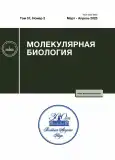Molecular Mechanisms to Optimize Gene Translation Elongation Differ Significantly in Bacteria with and without Non-Ribosomal Peptides
- Authors: Klimenko A.I.1, Lashin S.A.1, Kolchanov N.A.1, Afonnikov D.A.1, Matushkin Y.G.1
-
Affiliations:
- Institute of Cytology and Genetics, Siberian Branch, Russian Academy of Sciences
- Issue: Vol 57, No 2 (2023)
- Pages: 155-165
- Section: БИОИНФОРМАТИКА И СИСТЕМНАЯ КОМПЬЮТЕРНАЯ БИОЛОГИЯ
- URL: https://journals.rcsi.science/0026-8984/article/view/138604
- DOI: https://doi.org/10.31857/S002689842302012X
- EDN: https://elibrary.ru/EGGOIC
- ID: 138604
Cite item
Full Text
Abstract
Non-ribosomal peptides play an important role in the vital activity of bacteria and have an extremely broad field of biological activity. In particular, they act as antibiotics, toxins, surfactants, siderophores, and also perform a number of other specific functions. Biosynthesis of these molecules does not occur on ribosomes but by special enzymes that form gene clusters in bacterial genomes. We hypothesized that the presence of non-ribosomal peptide synthesis pathways is a specific feature of bacterial metabolism, which may affect other vital processes of the cell, including translational ones. This work was the first to show the relationship between the translation regulation mechanism of protein-coding genes in bacteria, which is largely determined by the efficiency of translation elongation, and the presence of gene clusters in the genomes for the biosynthesis of non-ribosomal peptides. Bioinformatic analysis of the translation elongation efficiency of protein-coding genes was performed in 11679 bacterial genomes, some of which contained gene clusters of non-ribosomal peptide biosynthesis and some of which did not. The analysis showed that bacteria whose genomes contained clusters of non-ribosomal peptide biosynthetic genes and those without such gene clusters differ significantly in the molecular mechanisms that ensure translation efficiency. Thus, among microorganisms whose genomes contain gene clusters of non-ribosomal peptide synthetases, a significantly smaller part of them is characterized by optimized regulation of the number of local inverted repeats, while most of them have genomes optimized by the averaged energy of inverted repeats studs in mRNA and additionally by codon composition. Our results suggest that the presence of non-ribosomal peptide biosynthetic pathways in bacteria may influence the structure of the overall bacterial metabolism, which is also expressed in the specific mechanisms of ribosomal protein biosynthesis.
About the authors
A. I. Klimenko
Institute of Cytology and Genetics, Siberian Branch, Russian Academy of Sciences
Email: mat@bionet.nsc.ru
Russia, 630090, Novosibirsk
S. A. Lashin
Institute of Cytology and Genetics, Siberian Branch, Russian Academy of Sciences
Email: mat@bionet.nsc.ru
Russia, 630090, Novosibirsk
N. A. Kolchanov
Institute of Cytology and Genetics, Siberian Branch, Russian Academy of Sciences
Email: mat@bionet.nsc.ru
Russia, 630090, Novosibirsk
D. A. Afonnikov
Institute of Cytology and Genetics, Siberian Branch, Russian Academy of Sciences
Email: mat@bionet.nsc.ru
Russia, 630090, Novosibirsk
Yu. G. Matushkin
Institute of Cytology and Genetics, Siberian Branch, Russian Academy of Sciences
Author for correspondence.
Email: mat@bionet.nsc.ru
Russia, 630090, Novosibirsk
References
- Caboche S., Pupin M., Leclère V., Fontaine A., Jacques P., Kucherov G. (2008) NORINE: a database of nonribosomal peptides. Nucl. Acids Res. 36, 326–331. https://doi.org/10.1093/nar/gkm792
- Süssmuth R.D., Mainz A. (2017) Nonribosomal peptide synthesis – principles and prospects. Angew. Chemie – Int. Ed. 56, 3770–3821.
- Kim H.U., Blin K., Lee S.Y., Weber T. (2017) Recent development of computational resources for new antibiotics discovery. Curr. Opin. Microbiol. 39, 113–120.
- Blin K., Shaw S., Kautsar S.A., Medema M.H., Weber T. (2021) The antiSMASH database version 3: increased taxonomic coverage and new query features for modular enzymes. Nucl. Acids Res. 49(D1), D639‒D643.
- Лихошвай В.А., Матушкин Ю.Г. (2000) Предсказание эффективности экспрессии генов по их нуклеотидному составу. Молекуляр. биология. 34, 406–412.
- Likhoshvai V.A., Matushkin Yu.G. (2002) Differentiation of single-cell organisms according to elongation stages crucial for gene expression efficacy. FEBS Lett. 516. 87–92.
- Соколов В.С., Зураев Б.С., Лашин С.А., Матушкин Ю.Г. (2014) EloE – веб-приложение для оценки эффективности элонгации трансляции генов. Вавиловский журн. генетики и селекции. 18, 904–909.
- Korenskaia A.E., Matushkin Y.G., Lashin S.A., Klimenko A.I. (2022). Bioinformatic assessment of factors affecting the correlation between protein abundance and elongation efficiency in Prokaryotes. Internat. J. Mol. Sci. 23(19), 11996. https://doi.org/10.3390/ijms231911996
- Blin K., Medema M.H., Kottmann R., Lee S.Y., Weber T. (2017) The antiSMASH database, a comprehensive database of microbial secondary metabolite biosynthetic gene clusters. Nucl. Acids Res. 45, D555–D559. https://doi.org/10.1093/nar/gkw9601
- Filzmoser P., Hron K., Templ M. (2018) Applied compositional data analysis. with worked examples. In: Statistics. Springer Ser., Nature Switzerland AG, Cham, Switzerland. ISBN 978-3-319-96420-1
- Mukherjee S., Stamatis D., Bertsch J., Ovchinnikova G., Katta H.Y., Mojica A., Chen I.M.A., Kyrpides N.C., Reddy T.B.K. (2019) Genomes OnLine database (GOLD) v.7: Updates and new features. Nucl. Acids Res. 47(D1), D649–D659. https://doi.org/10.1093/nar/gky977
- Turner D.H., Sugimoto N. (1988) RNA structure prediction. Annu. Rev. Biophys. Biophys. Chem. 17, 167–192.
- Sharp P.M., Li W.H. (1987) The codon adaptation index – a measure of directional synonymous codon usage bias, and its potential applications. Nucl. Acids Res. 15, 1281–1295.
- Filzmoser P., Hron K., Reimann C. (2007) Principal component analysis for compositional data with outliers. Environmetrics. 20, 621–632.
Supplementary files















